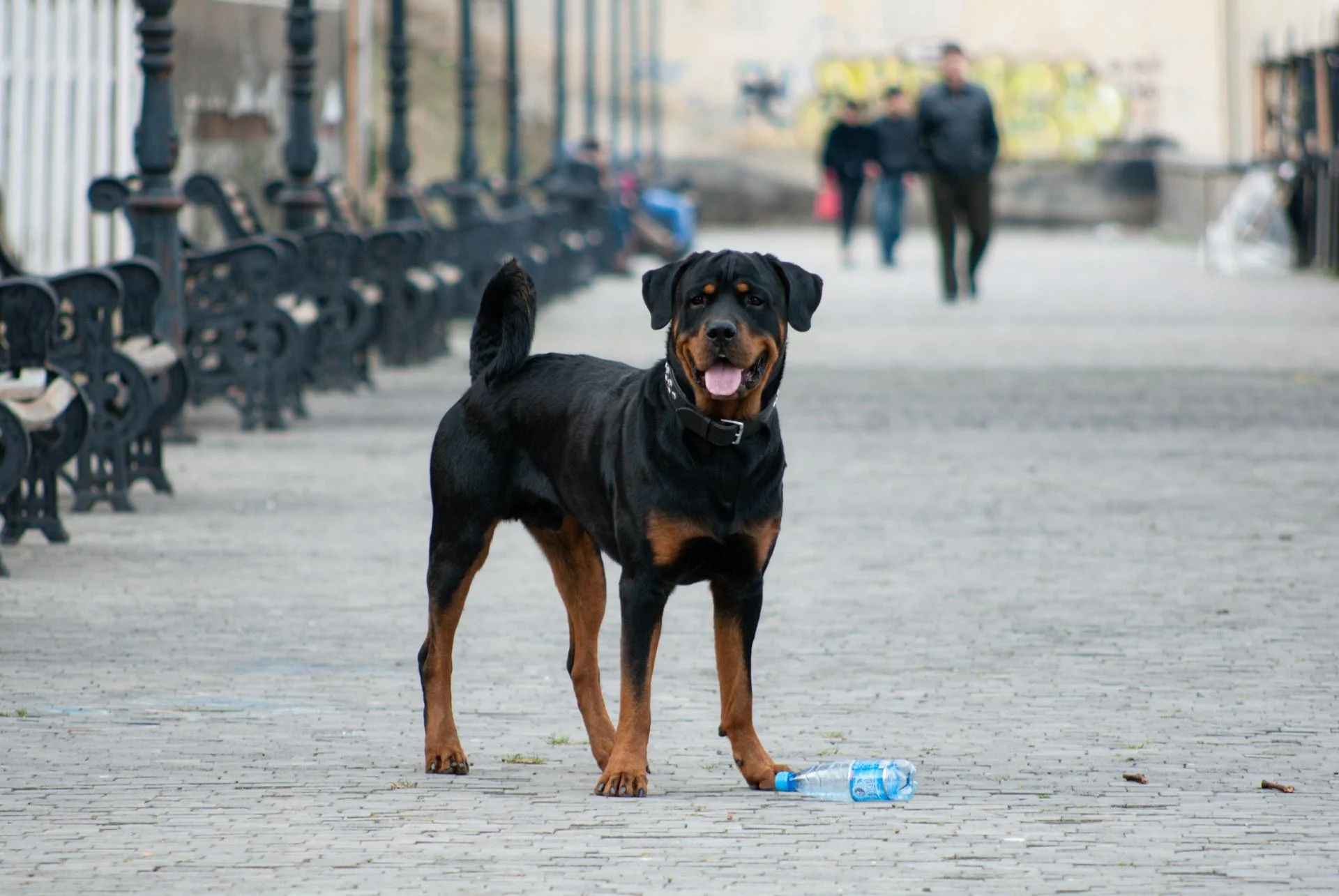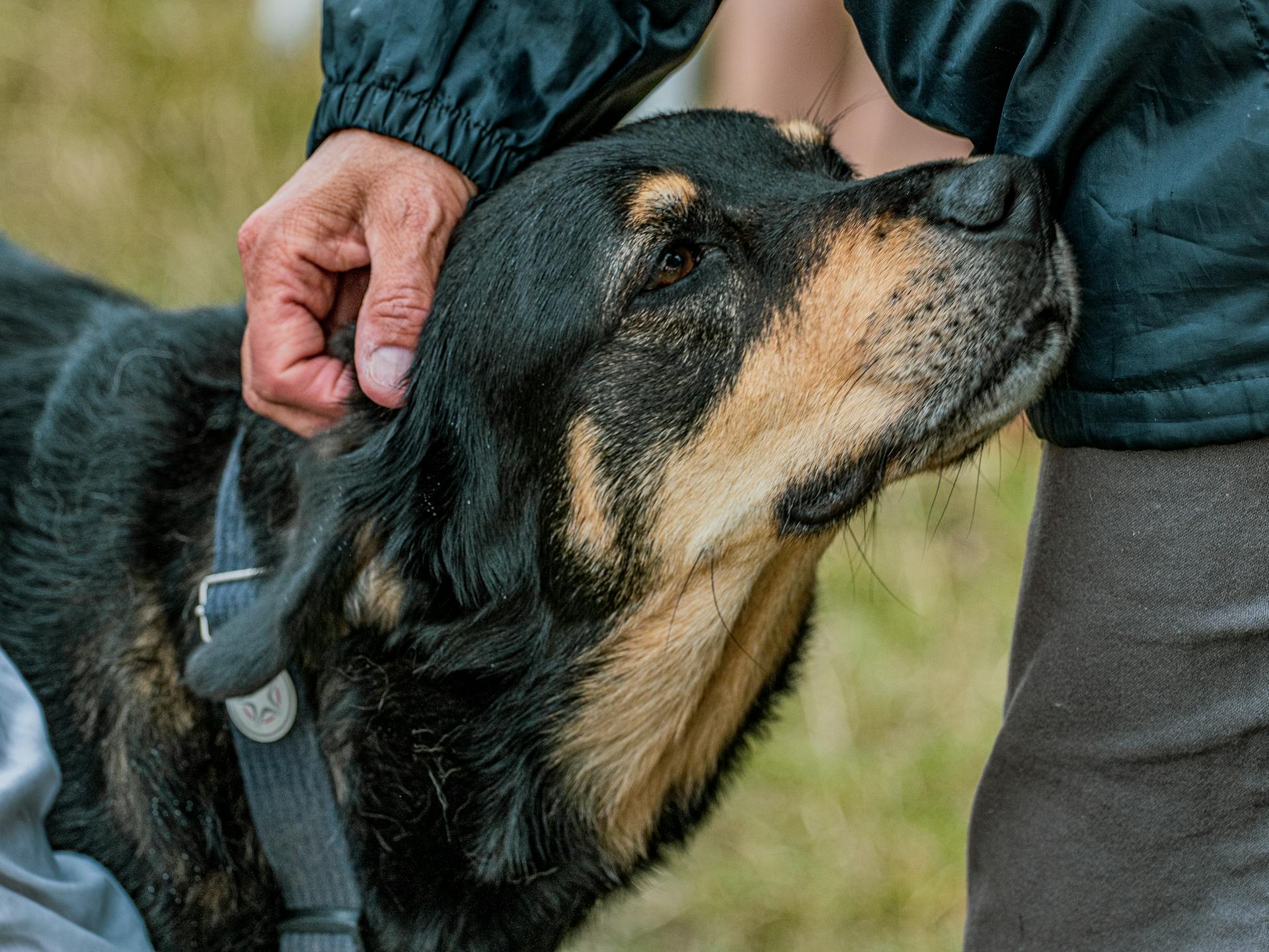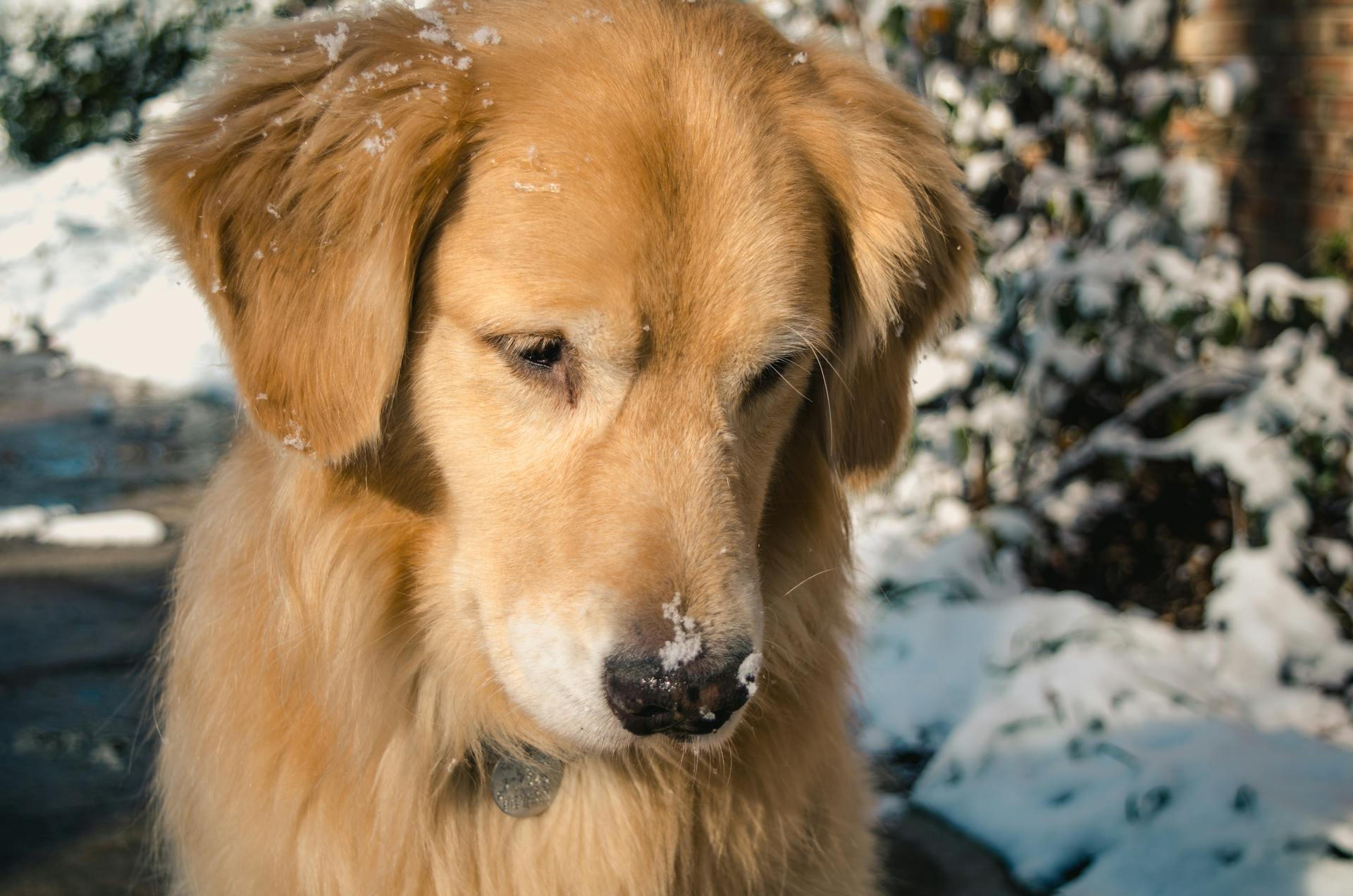
Red Rottweilers are a unique and beautiful variation of the classic Rottweiler breed. They have a distinctive red coat color, which can range from a deep, rich red to a lighter, more golden hue.
Red Rottweilers are often referred to as "red rotties" due to their striking coloration. This color variation is caused by a genetic mutation that affects the production of the pigment eumelanin.
In terms of temperament, red Rottweilers are known for their loyal and affectionate nature. They thrive on human interaction and make great family pets.
Red Rottweilers are a medium to large breed, with males weighing between 95 and 135 pounds and standing between 24 and 27 inches tall at the shoulder.
Check this out: Breeds of Rottweilers
Behavior and Character
Red Rotties are known to be very protective of their owners, but they're also calm and affectionate animals. They're naturally good hunters, but with the right training, they can be a loving companion for your family.
Red Rottweilers can be a bit reserved or guarded around strangers, so it's essential to socialize them from a young age. They're not always aware of their strength, so it's crucial to keep an eye on them around smaller animals.
Red Rotties are highly trainable, thanks to their intelligence and eagerness to please. With consistent training and socialization, they can develop into well-rounded, friendly dogs that are perfect for active families.
With proper training and socialization, Red Rottweilers can get along perfectly well with children and other animals. They'll be gentle and calm, even in chaotic situations.
Health and Life Expectancy
The red Rottweiler is a robust and healthy breed, but like all large dogs, it's not immune to certain health issues. Major concerns for this breed include CHD, elbow dysplasia, SAS, and osteosarcoma.
Life expectancy for the red Rottweiler is typically between 8-11 years. With proper care, most Rottweilers can live a long and happy life.
Some minor concerns for the breed include gastric torsion, hypothyroidism, and allergies. Monitoring diet and weight is crucial to prevent these issues.
Here is a list of potential health issues to be aware of:
- Major concerns: CHD, elbow dysplasia, SAS, osteosarcoma
- Minor concerns: gastric torsion, hypothyroidism, allergies
- Occasionally seen: PRA, cataract, seizures, vWD, panosteitis, entropion, ectropion
Health Issues
When owning a Rottweiler, it's essential to be aware of the potential health issues that can arise.
The breed is prone to major concerns such as CHD, elbow dysplasia, SAS, and osteosarcoma. These conditions can have a significant impact on your dog's quality of life and longevity.
Hip dysplasia is a common issue that can affect Rottweilers as they grow, particularly if they're not fed a balanced diet. Monitoring their weight and providing suitable food is crucial to prevent this.
Gastric torsion, hypothyroidism, and allergies are also minor concerns that can affect Rottweilers. These conditions may not be as severe as the major concerns, but they still require attention and care.
Some health issues are less common but still worth noting. These include PRA, cataract, seizures, vWD, panosteitis, entropion, and ectropion. Regular check-ups with a veterinarian can help identify these conditions early on.
Here are some suggested tests to keep in mind when caring for your Rottweiler:
- Hip test
- Elbow test
- Cardiac test
- Eye test
- vWD test (if necessary)
On average, Rottweilers can live for 8-11 years. With proper care and attention to their health, many Rottweilers can live well into their senior years.
Broaden your view: How Long Do Male Rottweilers Live
Life Expectancy
The life expectancy of a Rottweiler is a significant consideration for any dog owner. On average, an adult Rottweiler lives for ten years.
Most Rottweilers live between 8 and 11 years, which is a relatively long lifespan for a large breed dog. This means you'll have plenty of time to form a strong bond with your furry friend.
Rottweilers are easy to maintain when it comes to grooming, thanks to their short hair. A daily brush stroke is usually enough to keep them clean and well-groomed.
For more insights, see: Red Doberman Rottweiler Mix
What Causes Blue?
Blue Rottweilers result from a dilution of the standard black pigment, caused by specific recessive genes. This dilution gives them a coat that appears more grey or blue-like.
These rare colors are considered faults according to breed standards set by most kennel clubs.
The blue Rottweiler's appearance is not a result of any health issues, but rather a genetic variation.
Explore further: Blue Heeler and Red Heeler
Upkeep
The red rottie needs daily physical and mental activity, either in the form of long walks or jogs, or a vigorous game in a safe area.
This will help keep them happy and healthy, especially since they typically enjoy cool weather.
You'll want to avoid overexerting them in hot weather, as they may become overheated.
In terms of grooming, their coat care is minimal, consisting only of occasional brushing to remove dead hair.
Colors and Markings
A Rottweiler's coat is truly one of a kind. The base of their coat is typically black, but some have a diluted base causing them to have a lighter fur color.
Rottweilers have a distinctive saddle pattern, with a lighter coloring on their belly, legs, paws, and face. This pattern makes them look like they're wearing a saddle on their back.
The American Kennel Club (AKC) recognizes three fur colors for a purebred Rottweiler: black, mahogany, and rust. These colors can have varying degrees of intensity, and some Rottweilers may have a diluted base coat, resulting in a lighter fur color.
Rottweilers have specific markings that should be apparent on their coat. These marks can vary, but they should only take up 10 percent of their fur. Let's take a look at the typical coat markings found on a Rottweiler:
- Chest Markings: Two triangle-like marks on either side of their chest, typically higher toward the neck.
- Eye Dots: Dots above both of their eyes, giving them an arched eyebrow look.
- Muzzle Marks: A stripe of color running along each side of their muzzle.
- Tail Tone: A black top with an alternating color on the bottom.
- Leg Markings: Marks on the front and back legs, with the color on the lower portion of the front legs and the inner thigh of the back legs.
It's worth noting that these markings are essential for showing a Rottweiler at dog shows. If these marks are not present, you won't be able to qualify.
Training and Training Tips
The Rottweiler is a very intelligent animal, but he can be dominant and stubborn at times, so it's essential to start training him from an early age. This will help him develop good habits and prevent his dominant side from taking over.
To train a Red Rottweiler, you'll need to be firm and authoritative, but also patient and consistent. A training based on socialization is recommended to prevent his dominant side from coming out excessively. He's a hardworking and docile dog who will enjoy learning new things.
A Red Rottweiler's diet must be quite rich, as he's an imposing dog who needs enough daily nutrients to stay healthy and happy. Regular exercise and mental stimulation are also crucial to keep him happy and well-behaved.
Training a Puppy
Training a puppy requires consistency and patience, especially with breeds like the Red Rottweiler that can be dominant.
To start training from an early age is crucial, as it helps them develop good habits and prevents their dominant side from coming out excessively.
Red Rottweilers are highly trainable due to their intelligence and eagerness to please, making them a great match for active families who enjoy spending time outdoors.
However, they do require consistent training and socialization from a young age to ensure they develop into well-rounded, friendly dogs.
A firm and authoritative approach to training is necessary, as Red Rottweilers can be stubborn at times.
With regular exercise and a rich diet, a Red Rottweiler can thrive in a town environment, provided their owners spend quality time with them.
Their diet must be quite rich to meet their daily nutrient needs, especially considering their imposing size.
For your interest: Raw Food Diet for Rottweilers
Finding a Good Dog Trainer
Finding a good dog trainer may take a bit of research, but making the right choice will be worth the time.
It's essential to start by looking for a professional dog trainer. Finding a professional dog trainer is the key to making progress with your dog's training.
You can begin by asking for referrals from friends, family, or veterinarians who have experience with dog training. They can provide valuable insights and recommendations.
A good dog trainer will have certifications from reputable organizations, such as the Certification Council for Professional Dog Trainers (CCPDT). This ensures they have the necessary knowledge and skills to train dogs effectively.
It's also crucial to observe a training session before committing to a trainer. This will give you an idea of their training methods and how they interact with dogs.
Ultimately, finding a good dog trainer requires patience and research, but it's worth the effort to find someone who can help you achieve your training goals.
Curious to learn more? Check out: Are Labrador Retrievers Good Guard Dogs
General Information
The Red Rottie is a beloved breed known for its loving and loyal nature. They are a mix of a Redbone Coonhound and a Rottweiler, making them a unique and special companion.
Their size can vary, but they usually weigh between 60-90 pounds and stand between 22-27 inches tall. This makes them a medium to large breed that requires regular exercise to stay happy and healthy.
In terms of grooming, the Red Rottie has a short, smooth coat that requires minimal maintenance, making them a great choice for busy owners.
Breed History
The Rottweiler breed has a rich history that spans thousands of years. Its ancestors were probably Roman drover dogs, responsible for driving and guarding herds of cattle as they accompanied Roman troops on long marches.
The breed's early days were marked by its versatility, with dogs serving as both cattle drovers and protectors from bears. They also worked as draft dogs, but were eventually replaced by donkeys.
In southern Germany, the dogs mixed with various Sennehund (Mountain Dog) strains, which is believed to have contributed to the breed's development. The town of Rottweil became a center of cattle commerce, and the dogs drove and guarded cattle, as well as protected the money earned by the cattle sales.
The Rottweiler's popularity declined in the mid-nineteenth century, but a club was formed in 1901 to revive the breed. By 1931, the breed had gained AKC recognition and had arrived in America.
Interestingly, the breed's early standard allowed for a greater variation in color and coat than the current standard. This is why you may see photographs of early Rottweilers that appear more prolonged and lighter than expected.
The breed's history is well-documented, and it's fascinating to see how it has evolved over time. Today, Rottweilers are used as police, military, and mountain rescue dogs.
Take a look at this: Red Standard Poodle
How Gained Popularity

Red Rottweilers gained popularity in the 19th century due to their skills as working dogs. They were used for police work, search and rescue, and even as guide dogs for the visually impaired.
Their reputation as intelligent and loyal dogs grew, making them a sought-after breed. They were recognized by various industries for their capabilities.
As their working roles became well-known, their popularity as family pets increased. Today, Red Rottweilers are known for their versatility in both working roles and as loving companions.
Is it Real?
The Red Rottweiler is a rare sight, but is it real? The chances of a red Rottweiler being naturally produced by two purebred parents are extremely low.
Rottweilers have been bred for generations to produce only black with tan/mahogany markings, and dogs of any other color were disqualified. This means that the chances of a red Rottweiler being naturally produced are slim.
Some unscrupulous breeders might try to pass off rare puppies as "special" or "desirable", but it's essential to be aware of this. They might charge more for these puppies, which can be a red flag.
Readers also liked: Red English Setter Puppies
Frequently Asked Questions
Are red Rottweilers rare?
Yes, red Rottweilers are rare due to a recessive gene that affects their coat color. This genetic trait makes them less common than black and rust Rottweilers.
Featured Images: pexels.com


